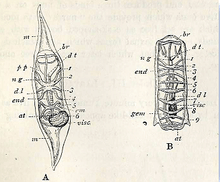Salpa fusiformis
| Salpa fusiformis | |
|---|---|
 | |
| 1804 illustration by Georges Cuvier of Salpa fusiformis anatomy: A chain form; B solitary form; 1-9 : muscle bands; em - embryo; m - mantle; visc - visceral mass or nucleus | |
| Scientific classification | |
| Kingdom: | Animalia |
| Phylum: | Chordata |
| Subphylum: | Tunicata |
| Class: | Thaliacea |
| Order: | Salpida |
| Family: | Salpidae |
| Genus: | Salpa |
| Species: | S. fusiformis |
| Binomial name | |
| Salpa fusiformis Cuvier, 1804 | |
| Synonyms[1] | |
| |
Salpa fusiformis, sometimes known as the common salp,[1] is the most widespread species of salp. They have a cosmopolitan distribution, and can be found at depths of 0 to 800 m (0 to 2,625 ft).[2] They exhibit diel vertical migration, moving closer to the surface at night.[3][4] They can occur in very dense swarms, as solitary zooids or as colonies. Solitary zooids usually measure 22 to 52 mm (0.87 to 2.05 in) in length. They are barrel-shaped and elongated, with a rounded front and a flat rear. Aggregate zooids are 7 to 52 mm (0.28 to 2.05 in) in length individually (excluding projections). They are usually barrel or spindle-shaped.[2]
References
- 1 2 L. Madin (2014). "Salpa fusiformis Cuvier, 1804". World Register of Marine Species. Retrieved 21 January 2015.
- 1 2 Matthijs van Couwelaar (2003). "Salpa fusiformis". Zooplankton and Micronekton of the North Sea. Marine Species Identification Portal. Retrieved 21 January 2015.
- ↑ "Salpa fusiformis Cuvier, 1804". JelliesZone. Retrieved 21 January 2015.
- ↑ "Salpa fusiformis". Zooplankton of the San Diego Region. Scripps Institution of Oceanography. Retrieved 21 January 2015.
This article is issued from
Wikipedia.
The text is licensed under Creative Commons - Attribution - Sharealike.
Additional terms may apply for the media files.